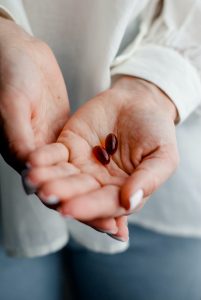8.2 Why Do TEENS / ADULTS / SENIORS Misuse Prescription Drugs?
Introduction
About 22% of Canadians over the age of 15 years old use psychoactive prescription drugs in some form according to the 2017 Canadian Tobacco, Alcohol and Drugs Survey. There is an urgent challenge to reduce the related harms of prescription drugs while ensuring timely and appropriate access to them for medical applications. This challenge is particularly pressing for opioids, but also for stimulants and sedatives. CCSA (Canadian Centre of Substance Use and Addiction) synthesizes research on demographic and use trends for psychoactive prescription drugs, provides targeted materials on associated issues, and fosters relationships that support prevention, harm reduction, treatment and recovery efforts.1
Why Do TEENS / ADULTS / SENIORS Misuse Prescription Drugs?

Over half of Canadian adults aged 18 to 79 have used at least one prescription medication in the past month2
New results show that 55% of adults aged 18 to 79 used at least one prescription medication in the past month, while 36% used two or more, and 24% used three or more. The use of prescribed medication increased with age (taking one medication or more: 38% at ages 18 to 39, 56% at ages 40 to 59, and 81% at ages 60 to 79; taking three medications or more: 7% at ages 18 to 39, 22% at ages 40 to 59, and 52% at ages 60 to 79).

Overall, a higher proportion of females aged 18 to 59 (55%) reported using prescription medications, compared with males (38%), while for 60- to 79-year-olds, there was no significant difference between males (80%) and females (81%). These results are based on data combined from two cycles of the Canadian Health Measures Survey (CHMS), 2016 and 2017, and 2018 and 2019.
Along with hospital costs, medications constitute one of the major health spending categories in Canada, as reported by the Canadian Institute for Health Information. Spending on prescription medication accounted for 13% of total national health expenditures in 2019.
At least 1 in 10 Canadian adults are taking medications to treat high blood pressure, high blood cholesterol or mood disorders
Among Canadian adults, the most commonly reported prescription medications were to treat high blood pressure (16%); high blood cholesterol (12%); and mood disorders (10%) such as depression, bipolar disorder, mania or dysthymia. The use of these prescription medications was significantly higher in older age groups. Within the 60-to-79 age group, the use of prescription medications to treat high blood pressure (42%), high blood cholesterol (34%) and mood disorders (13%) was more common.
Females are twice more likely than males to take medication to treat mood disorders

Overall, the use of prescription medications to treat high blood pressure and high blood cholesterol was significantly more common in males than females. However, the use of prescription medication to treat mood disorders was twice as common among females (14%) than males (7%).
Prescription medication use by people with high blood pressure or high blood cholesterol
The increase in prescription medication use with age is consistent with the similar trend observed in the prevalence of reported high blood pressure and high blood cholesterol. For example, the number of people who reported having high blood pressure or high blood cholesterol increased significantly with age (data not shown).
The CHMS collected self-reported information on chronic conditions and performed blood pressure measurements and lipids blood tests to determine the prevalence of high blood pressure and high blood cholesterol.
The survey results indicate that the majority of adults with high blood pressure diagnosed by a health professional were taking prescription medication to treat it (85%). However, according to the direct measure of blood pressure collected during this survey, medication was effectively treating the blood pressure of 58% of these adults.
Survey results also indicate that nearly half of adults were taking medication to treat high blood cholesterol diagnosed by a health professional. Based on the direct measures obtained during the survey, medication was effectively treating the cholesterol of 86% of these adults.
Detailed results for high blood pressure based on data from direct measurements and self-reported use of medication were released in the fact sheet “Blood pressure of adults, 2016-2019” (published in March 2021). Similar detailed results for high blood cholesterol are released in the fact sheet “Cholesterol levels of adults, 2016-2019” (available today).
Chart – Figure 8.2.4
The fact sheets “Blood pressure of adults, 2016-2019” and “Cholesterol levels of adults, 2016-2019” are available in the publication Health Fact Sheets (82-625-X).

Why Do TEENS Misuse Prescription Drugs?

Teenagers are in the process of growing, changing, experiencing, making decisions, so many more new experiences daily and to make and experience them through their own lens and independently. Sometimes, with new experiences decisions, some are easier to make better choices than others.
When we’re looking at Prescription drug abuse in teens, this is a serious problem that can have lasting effects on your child, family and community.
Why Teens Are Vulnerable to Prescription Drug Abuse
As a concerned parent or loved one, it’s important to become educated in how to recognize the challenges and support them.
Important information to know:
- probably have some drugs sitting in your home right now
- even Doctor prescribed medication are drugs
- some have the potential for abuse and negative reactions
- Kids often experiment
- sometimes from peer pressure, curiosity, or looking for ways to cope with negative emotions
- it’s easier to look for things around the home without the resources to buy illicit substances
- Painkillers and cough syrup are among two of the most-abused substances
- Teens may not be able to buy their own drinks, but may sneak some of Mom and Dad’s or at a friend’s house
- bathroom medicine cabinets are easy to access for pills that provide mild to moderate highs
- prescription drugs aren’t completely safe just because doctors prescribe them
- prescription drugs have side effects and that is taken into consideration when they are prescribed for someone specifically and monitored
- abusing opioids and other narcotics can lead to dependency and negative consequences
- if they can’t find drugs and alcohol at home they will find them elsewhere
- they may rely on friends
- they may buy pills on the street or get them off “friends”
Signs of Prescription Drug Abuse in Teens

Signs indicating drug abuse include:
- Change in behaviour
- Missing pills or prescribed medication
- Missing cough syrup
- Asking for cash often
- items disappearing (money or items)
- Change in sleeping habits
- Falling grades
- Aggressive behaviour
Family Support
If your daughter or son’s problems change or steadily grow worse over weeks and months, problems at school are escalating, or any challenging behaviour is happening more often, it’s important to have a conversation and see what is going on. There are many programs throughout Canada in all provinces that can assist families, friends and youth. Programs vary from education, individualized therapy in small group settings, support groups, outpatient, residential and virtual.
It all begins with a conversation and then finding the right program for the youth and family to begin the journey.
Examples of Supports or Information for Teens / Youth
- Youth Addiction & Concurrent Disorders Service – The Youth Addiction and Concurrent Disorders Service (YACDS) offers treatment to young people (14-24 years) who have substance use challenges/concerns, with or without concurrent mental health concerns.
- Preventing Problematic Substance Use Through Positive Youth Development – The Centre for School Mental Health at Western University and the Public Health Agency of Canada have partnered to develop a series of resources for school communities to promote positive youth development through school-based initiatives. Following an extensive literature review and consultations from diverse stakeholders (i.e., representing educators, principals, mental health organizations, researchers, and government organizations), three key themes emerged to guide the development of these resources: (1) promoting well-being, (2) creating welcoming environments, and (3) effective programming.
- One in two Canadian homes have prescription medications that are potentially dangerous, and most do not store them in a secure place
- Prescription Drug Abuse in Teens
- CMHA Mental Health Services for Gender-Diverse and Sexual-Minority Youth
Why Do ADULTS Misuse Prescription Drugs?
When Adults go to a health professional to get assistance with a health condition quite often it ends with receiving a prescription medication prescribed for a valid reason.
Although there are regulations for each medication, which are regulated by Health Canada through the Food and Drugs Act to ensure their safety, effectiveness and quality, there are times when it becomes an unexpected challenge.

Even though many prescription drugs have acceptable safety profiles when used as prescribed, it can easily become a challenge when taken in a larger dose, missed a dose, using a different route of administration or used for non-medical reasons without a prescription. This situation may or may not be intentionally created. Either way problematic use patterns and negative health outcomes happen. Being aware of the restrictions on the label (e.g., driving or operating heavy machinery), when using the drug, as they can have problematic consequences.
There are many different forms of capsules, syrups, sublingual, skin patches and liquids for injections which are very specific for a patients’ health conditions. Of these, the most commonly used varieties that can lead to problematic use are:
- Opioids, a broad group of pain-relieving drugs that work help with pain management
- Stimulants, which have many different uses, assist with your CNS (Central Nervous System) and work with those with attention deficit hyperactivity disorder (ADHD)
- Sedatives are a type of medication that slows down your brain activity. They are used to treat conditions like anxiety and sleep disorders.
It’s important to be aware, have an ongoing conversation with your physician, or healthcare worker or have someone to support you and have a conversation with so that you can take medications as required.
Why Do SENIORS Misuse Prescription Drugs?

Seniors’ Misuse of Prescriptions is a serious and growing health issue for seniors in Canada.
In Canada, 43.9% of adults > 55 years of age have used a prescription opioid and 1.1% of that group have done so daily (or almost daily) in the last year (Canadian Centre on Substance Use and Addiction, 2018).
As there is a growing population of older adults, there is a growing population that is developing opioid use disorder (OUD). In addition to this, there are many older adults with longstanding OUD or SUD (Substance Use Disorder) including many seniors who use illicit opioids, that require treatment for their addiction and related health problems.
Many agencies do not offer Treatment Services to those over 65, so there is the added systems navigation challenge to find these agencies who specialize in working with this issue with seniors which is adding to putting Seniors at risk.
Tools for Seniors and families:
Opioid Use Among Older Adults Brochure
Printer-friendly version of this brochure
Tools for Clinicians / Health Care Workers:
Canadian Guidelines on Opioid Use Disorder Among Older Adults PDF
The purpose of these clinical guidelines is to highlight the issues facing older adults with, or at risk for, an OUD, and to provide recommendations for the prevention, screening, assessment, and treatment of an OUD in those ≥ 65 years of age.
CCSMH Online Resources for Opioid Use Disorder
This list is designed to help primary health care & clinical care providers assess and discuss with persons aged 65 or older, the potential risks and benefits of opioid use.
Canadian Guidelines on Opioid Use Disorder Among Older Adults
Published in the Canadian Geriatrics Journal, March 2020
The New Canadian Guidelines on Opioid Use Disorder Among Older Adults
Learn about CCSMH’s Canadian Guidelines detailing the evidence and best practice recommendations for the prevention, assessment and treatment of opioid use disorder among older adults.
Example Resources for Seniors
Physicians, Health Care Workers, Patients and Pharmacists can all play a role in identifying and Preventing non-medical use of Prescription Drugs.
Non-medical use of Prescription Drugs is a problem and physicians, health care workers, patients and pharmacists can all work together to prevent, slow down or stop non-medical use of prescription drugs. There are times when certain patients can benefit from specific prescription stimulants, sedatives, or opioid pain relievers. Therefore, it is important for physicians to balance the legitimate medical needs of patients with the potential risk of misuse and related harms.
Physicians:
When physicians prescribe medications – doctors are in a position to identify misuse of prescriptions as well as take measures to prevent escalation of a patient’s misuse of a substance.

- can ask questions about drugs
- help patients recognize whether or not there is a problem
- offer non-opioid medications or non-medical medications
- refer to appropriate treatment or set recovery goals if needed
- refer to other resources for medical and health professionals
- be aware of rapid increases in the amount of medication needed
- be aware of frequent, unscheduled refill requests
- watch for doctor shopping (looking for medications)
Patients:
Patients can take many steps to ensure that they are using all prescription medication appropriately by:

- following the directions as explained by the pharmacist or on the label
- being aware of all potential interactions that can happen with food, other drugs they are taking, supplements as well as alcohol
- keeping a regular routine and not stopping, forgetting or changing a dose regimen without discussion with the doctor or pharmacist
- only using their own prescription medication
- keeping a record of all medications that you are on and carrying that with you to all medical appointments (it should also include all prescriptions, over-the-counter medicines, and dietary and herbal supplements)
- never share their prescription medication
- keep prescription stimulants, sedatives and opioids out of reach of children/youth/adults and stored somewhere safe (so there are not easily obtainable)
- always properly discard unused or expired medication by returning them to a pharmacist for proper disposal
Pharmacists:
Pharmacists can take many steps to ensure that they are using all prescription medication appropriately by:

- helping patients understand the medication they are taking, how the medication works and explaining all the instructions
- being aware of prescription falsifications or alterations
- being the first line of defence, in recognizing problematic patterns with prescription drug use
- using hotlines that have been developed by pharmacies to notify others in that region of a fraudulent prescription
- using systems that are in place for physicians, and pharmacists to help track opioid-prescribing and dispensing patterns in patients.
Medication Formulation and Regulation
There are many manufacturers of prescription drugs who are continuing to work/create new formulations of opioid medications, known as abuse-deterrent formulations (ADF). These formulations are using technologies designed to prevent people from misusing them by snorting or injection.
Some of the approaches that are currently being used or studied for use include:
- physical or chemical barriers (prevents crushing, grinding, or dissolving of drug products)
- agonist/antagonist combinations (which will counteract the drug)
- aversive substances (create unpleasant sensations if the drug is taken in a way other than directed)
- delivery systems (long-acting injections or implants)
- new molecular entities or prodrugs (renders it inactive unless it is taken orally)
References
Figure 8.2.4 – Chart -Government of Canada, Statistics Canada. (2021d, June 28). The Daily — Prescription medication use among Canadian adults, 2016 to 2019. https://www150.statcan.gc.ca/n1/daily-quotidien/210628/dq210628e-eng.htm
CCSA (Canadian Centre for Substance Use and Addiction). (n.d.). Prescription Drugs. Retrieved April 25, 2022, from https://www.ccsa.ca/prescription-drugs
CCSMH (Canadian Coalition for Seniors’ Mental Health). (2020, March). Opioid Use Disorder Among Older Adults. Retrieved April 25, 2022, from https://ccsmh.ca/substance-use-addiction/opioids/#:~:text=According%20to%20the%20World%20Health,2012%3B%20UNODC%2C%202018).
NIDA. 2021, June 13. How can prescription drug misuse be prevented?. Retrieved from https://nida.nih.gov/publications/research-reports/misuse-prescription-drugs/how-can-prescription-drug-misuse-be-prevented on 2022, April 29

